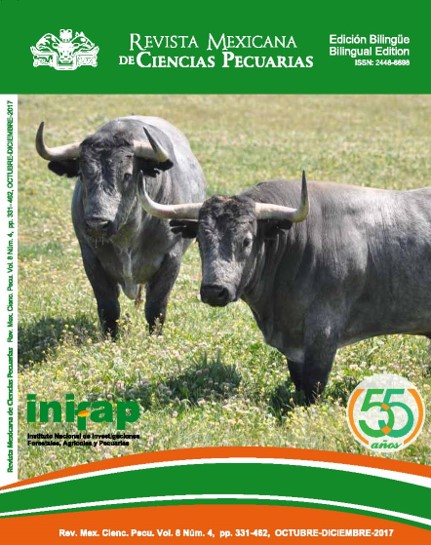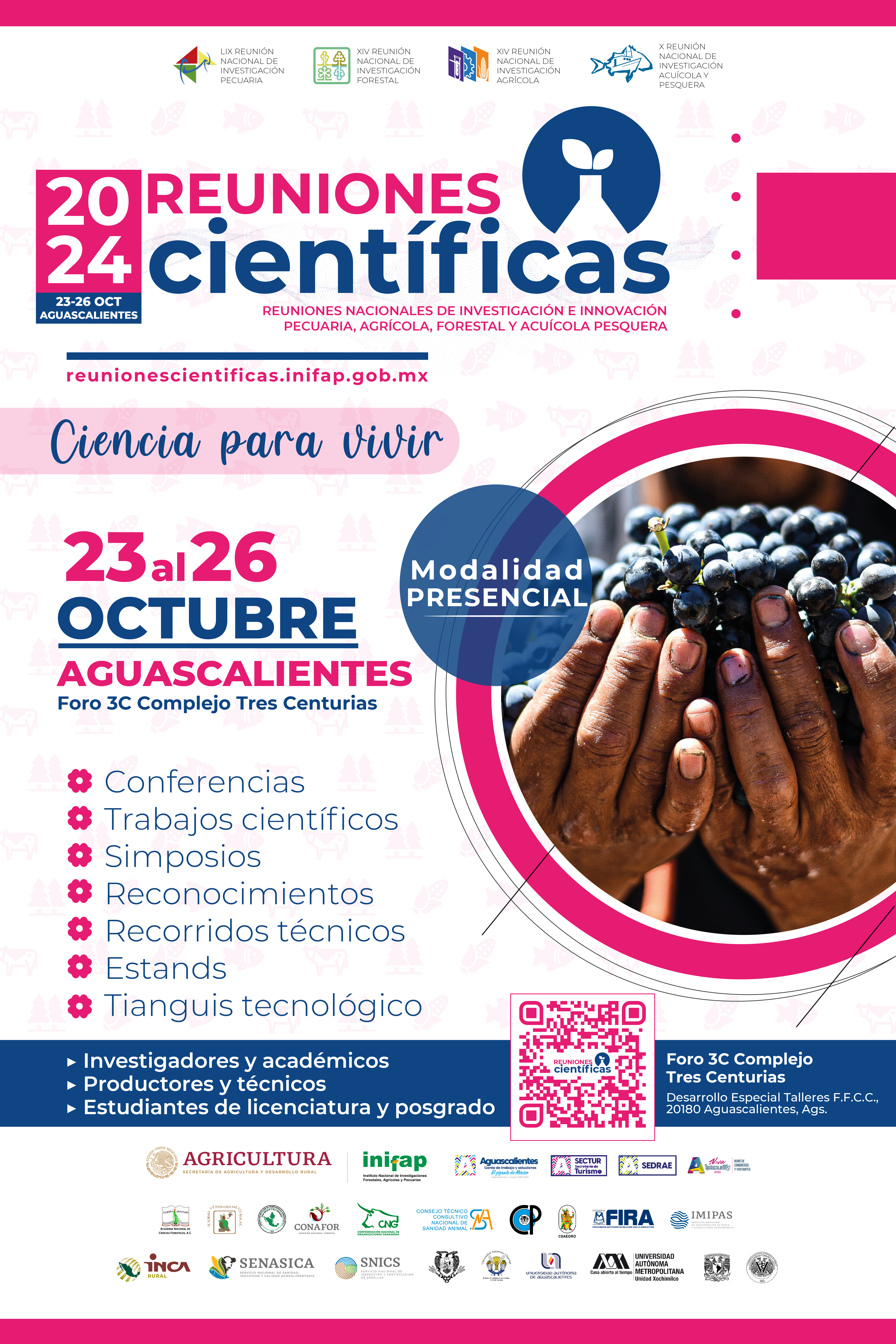Changes in the water soluble fraction of eggs from hens fed with shrimp meal stored at different times and temperatures
DOI:
https://doi.org/10.22319/rmcp.v8i4.4183Keywords:
Shrimp heads meal, Egg quality, Storage.Abstract
The objective of this study was to determine the effect of storage conditions on the water soluble fraction in eggs from hens fed with a conventional diet and a 20 % shrimp by-products meal (SBPM). Ninety (90) Isa-Brown laying hens 32 wk age were distributed in two treatments: Control and SBPM. The productive variables were evaluated during 4 wk. Eggs (n= 250) collected for this study, were stored at 15 and 30 d/ 20° and 4 °C, taking as reference fresh eggs (not stored). The parameters studied were egg weight, Haugh Units, pH, crude protein, essential amino acids and water soluble vitamins. The results were analyzed using a 2x2x3 factorial design and the differences between means were compared using the Tukey test. The data obtained showed that the quality indexes of the water soluble fraction of egg were significantly affected (P<0.05) by the time and the temperature of storage and differences (P<0.05) in protein alone due to the effect of SBPM inclusion. At room temperature (20 °C) and longer storage time (30 d), a decrease in internal egg quality was observed according to the results of this study. Therefore, it is concluded that both temperature and time are one of the main factors influencing the eggs quality of the water-soluble fraction of the egg during storage.
Downloads
References
Casas VM, Ponce D. Estudio del potencial pesquero y acuícola de Baja California Sur. SEMARNAP, Gob. Edo. BCS, FAO, INAPESCA, UABCS, CIB, CICIMAR y CET del MAR. México, Vol. I. 1999.
Li-Chan EC, Powrie D, Nakai S. The chemistry of eggs and egg products. In: Yoshinori M editor. Egg bioscience and technology. New Jersey, USA: John Wiley and Sons; 2008.
Goddard JS, Perret JSM. Co-drying fish silage for use in aquafeeds. Anim Feed Sci Tech 2005;118:337-342.
Carranco JM, Calvo CC, Arellano ML, Pérez-Gil RF, Ávila GE, Fuente MB. Inclusión de la harina de cabezas de camarón Penaeus sp. en raciones para gallinas ponedoras. Efecto sobre la concentración de pigmento rojo en yema y calidad de huevo. Interciencia 2003;28:328-333.
Carranco JM, Sanginés G, Morales B, Carrillo D, Ávila G, Fuente M, et al. Shrimp head meal in laying hen rations and its effects on fresh and stored egg quality. Interciencia 2006;31:822-827.
UNA. Unión Nacional de Avicultores. 2015 [en línea]. http://www.una.org.mx Consultado 22 Feb, 2016.
NMX. Norma Mexicana FF-079-SCFI. Productos avícolas. Huevo fresco de gallina. Especificaciones y métodos de prueba. Secretaría de Economía. México. 2004.
Buba W, Dafwang II, Olugbemi TS, Opoola E, Iyiola-Yunji AO, Okafor EC. Effects of local storage methods on egg internal quality parameters during cold season. J Amin Prod Res 2013;25:45-51.
Ahn DU, Sell J, Chamruspollet M, Jeffrey M. Effect of dietary conjugated linolenic acid on the quality characteristics of chicken eggs during refrigerated storage. Poult Sci 1999;78:922-928.
Guerra M. Factores que afectan la calidad del huevo.
Agricultura 2000;(4):38-40.
AOAC. Official methods of analysis, Ass. Off. Agric. Chem. 17th rev. ed. Washington DC, USA. 2000.
National Research Council, (NRC). Nutrient requirement of poultry. 9th ed, Washington DC: Academy Press. Newsletter. 1994.
NOM. Norma Oficial Mexicana 062-ZOO. Especificaciones técnicas para la producción, cuidado y uso de los animales de laboratorio. Secretaría de Agricultura, Ganadería, Desarrollo Rural, Pesca y Alimentación, México. 1999.
Charley H. Tecnología de alimentos. Procesos químicos y físicos en la preparación de alimentos., México: Limusa; 2004.
Castro GM, Carrillo DS, Pérez-Gil RF, Calvo CC. Composición química de la langostilla y procesos tecnológicos. En: Aureoles-Gamboa D, Balart EF editores. La langostilla: biología, ecología y aprovechamiento. Centro de Investigaciones Biológicas del Noroeste, S.C. México. 1995.
Cruz-Suárez LE, Ricque-Marie D, Martínez-Vega JA, Wesche-Eveling P. Evaluation of two shrimp by-product meals as protein sources in diets for Penaeus vannamei. Aquaculture 1993;115:53-62.
FAO. Joint FAO/WHO Codex Alimentarius Commission. Codex alimentarius. Food & Agriculture Org. 1994.
Andrade DR, Torres GR, Montes MEJ, Chávez BMM, Naar OV. Elaboración de un sazonador a base de harina de cabezas de camarón de cultivo (Penaeus sp). Rev Fac Química Farmacéutica, Colombia. 2007;14:109-113.
Toma RB, Meyers S. Isolation and chemical evaluation of protein from shrimp cannery effluent. J Agric Food Chem 1975;23:632-635.
Quintero HE. Ingredientes para alimentos acuícolas - Parte I. American Soybean Association, 2009.
Huyghebaert G. Fisiología de la puesta con énfasis en la calidad de la cáscara. Selecciones avícolas. Abril 2006.
Berardinelli A, Ragni L, Giunchi A, Gradari P, Guarnieri A. Physical-mechanical modifications of eggs for food-processing during storage. Poult Sci 2008;87:2117-2125.
Estrada MM, Galeano LF, Herrera MR, Restrepo LF. Efecto de la temperatura y el volteo durante el almacenamiento sobre la calidad del huevo commercial. Rev Colomb Cienc Pecu 2010;23:183-190.
Zalapa RA. Correlación gráfica entre el peso del huevo, la altura de la clara y las Unidades Haugh. 2016. www.researchgate.net/publication/290523405. Consultado 20 Dic, 2016.
Scott TA, Silversides FG. The efect of storage and strain of hen on egg quality. Poult Sci 2000;79:1725-1729.
Croguennec T, Nau F, Brulé G. Influence of pH and salts on egg white gelation. J Food Sci 2002;67:608-614.
Grobas S, Mateos G. Influencia de la nutrición sobre la composición nutricional del huevo. XII Curso de Especialización FEDNA. 1996.
Desrosier NW. Elementos de tecnología de alimentos. 10ª reimpresión. México, DF: Compañía Editorial Continental SA; 1994.
Arias JL, Fernández MS, Nys Y. Importancia de la calidad del huevo. 2007. www.tecnovet.uchile.cl/CDA/tecnovet_articulo.htm. Consultado 29 Jun, 2015.
Naber EC, Squires M. Vitamin profiles of eggs as indicators of nutritional status in the laying hen: diet to egg transfer and commercial flock survey. Poult Sci 1993;72:1046-1053.
Downloads
Published
How to Cite
-
Abstract1202
-
PDF (Español)579
-
HTML (Español)936
-
XML (Español)340
Issue
Section
License

This work is licensed under a Creative Commons Attribution-NonCommercial-ShareAlike 4.0 International License.






